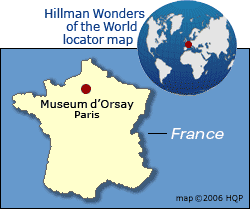Museum d'Orsay
 Why the
Museum d'Orsay
is special
Why the
Museum d'Orsay
is specialThis Parisian institution has become one of the world's greatest and most popular museums in just a couple of decades because of its stunning art collection.
Museum d'Orsay tips and insights
Time span and focus
The Museum d'Orsay focuses on a specific period: from 1848 to 1914. The institution is most celebrated for its impressionist and post-impressionist artwork.
Remarkable collection
It includes works by Cezanne, Degas, Gauguin, Manet, Matisse, Monet, Renoir, Seurat, Van Gogh, among others.
Famous paintings
Some of the exhibited paintings in the Museum d'Orsay have been so widely published in books and other media that even an art neophyte would likely recognize them.
Museum d'Orsay building
It began life in 1900 as the Gare d'Orsay ("train station of Orsay"). In 1939 it closed. In the late 1970s it was slated for demolition to make room for a large hotel. Public pressure stifled those plans. In 1986, after being converted, the terminus became the Museum d'Orsay.
Main Hall
The main-hall exhibition space (see photo) preserves the train station layout. And, the sky-light roof enhances the artwork by bathing it with diffused daylight.
Location in France



